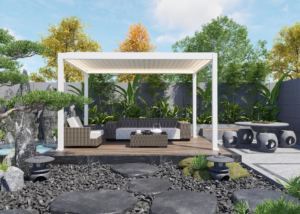
How expensive is it to make a pergola
Dreaming of adding a pergola to your backyard but unsure about costs? Pergola prices vary widely based on materials, size, and whether you DIY or
Curtain walls have become a hallmark of modern architecture, transforming the way buildings look and perform. But why might an architect choose to use a curtain wall? From sleek aesthetics to energy efficiency, curtain wall systems offer a wide range of benefits that make them a preferred choice for commercial, industrial, and even residential structures.
In this blog, we’ll explore the top reasons architects specify curtain walls in their building designs—and why they’re more than just a pretty face.

One of the primary reasons architects choose curtain walls is their ability to create striking, contemporary facades. Made from lightweight materials like aluminum and glass, curtain walls offer a clean, minimalistic look that enhances the visual appeal of any building.
They also provide immense design freedom. Whether it’s a sleek high-rise or a low-profile office complex, curtain walls can be customized to suit virtually any architectural vision. This versatility makes them ideal for both bold statements and refined elegance.
Curtain walls maximize the use of natural daylight, creating bright, open interiors that improve occupant comfort and productivity. With large expanses of glass, they offer unobstructed views of the outdoors, which is especially valued in urban developments or scenic locations.
Natural lighting not only enhances ambiance but also reduces dependence on artificial lighting—contributing to energy savings.
Modern curtain wall systems are designed with energy efficiency in mind. With advanced glazing options, thermal breaks, and insulating materials, they help control indoor temperatures, reduce heat loss in winter, and minimize heat gain in summer.
This leads to lower energy bills, reduced environmental impact, and improved sustainability—key factors in achieving green building certifications like LEED or BREEAM.
Although they are non-structural, curtain walls serve as a building’s external shield, offering protection against harsh weather conditions. High-quality systems are engineered to resist wind loads, rain, air infiltration, and UV exposure, enhancing the durability of the entire structure.
Some curtain wall systems even offer fire-rated or impact-resistant options, making them suitable for buildings that require added safety and performance.
Curtain walls are typically constructed using lightweight aluminum frames and glass, reducing the overall weight of the building envelope. This can lower foundation and structural support costs, particularly in tall buildings where weight savings are critical.
Their prefabricated, modular nature also enables faster installation, reducing labor costs and shortening construction timelines.
Buildings with curtain walls often have a higher perceived value due to their modern appearance and performance benefits. For developers and property owners, this can translate into higher rental rates, faster lease-up times, and improved return on investment.
Architects choose curtain walls not just for their visual appeal, but for the practical advantages they bring—energy efficiency, weather protection, natural light, and construction benefits. As architectural trends continue to evolve, curtain walls remain a smart, sustainable, and stylish choice for forward-thinking building designs.

Dreaming of adding a pergola to your backyard but unsure about costs? Pergola prices vary widely based on materials, size, and whether you DIY or

Thinking about investing in an aluminum pergola1 but wondering if it’s worth the cost? The lifespan of your pergola directly impacts its value and your

Thinking about adding a pergola to your outdoor space but unsure about material choices? Aluminum pergolas have gained popularity for their durability and low maintenance,
Are you considering tilt-up construction for your next project but worried about potential drawbacks? While this method offers many benefits, it also comes with some
When you hear “curtain wall” and “curtain system,” do they sound like the same thing? It’s easy to get them mixed up, especially in the

Ever wondered about those sleek, glass-covered buildings dominating city skylines? Chances are, they use curtain walls. But why are architects and builders choosing this system,
Before contacting suppliers, it’s essential to determine the exact specifications of the windows and doors you need. This includes:
The more detailed you are, the easier it will be for suppliers to provide accurate quotes and product options.
China has a vast manufacturing industry, so it’s crucial to find reliable suppliers who can deliver quality products on time. Here’s how to start your search:
Consider factors like the supplier’s reputation, certifications, and product quality. It’s also wise to work with suppliers who are accustomed to exporting to your region, as they’ll be familiar with international standards and shipping requirements.
Before placing a large order, request samples. Samples give you a chance to assess the quality firsthand and confirm that it meets your standards. Be prepared to cover the costs of samples and shipping, but consider it an investment in ensuring you’re working with a trustworthy supplier.
When reviewing samples, pay attention to:
Once you’ve selected a supplier, it’s time to negotiate terms. Most suppliers expect some level of bargaining, especially for larger orders. Important aspects to discuss include:
Quality assurance is crucial, especially when importing from abroad. Consider these inspection steps:
Importing windows and doors involves managing shipping logistics and navigating customs procedures. Here are some key factors:
After confirming quality, shipping terms, and pricing, you can place your order. Ensure that:
When the products arrive, inspect them thoroughly. Ensure there’s no damage from transit, and verify that everything matches your specifications. If there are any issues, address them with the supplier immediately.